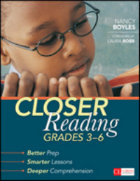10 Steps to Deeper Student Reading
 By Nancy Boyles
By Nancy Boyles
Teaching close reading well asks a lot of us as educators. If we’re serious about helping students delve deeper into text for more thorough understanding, we’ll need to plan thoughtfully for the close reading process from start to finish.
The 10 steps here outline key points to consider as teachers plan close reading instruction. For elaboration about each point (including lots of classroom resources), see my book Closer Reading, Grades 3-6 (Corwin, 2014). The questions following this list will also help you to chart your close reading journey.
10 steps to implementing closer reading
1. Identify a text you think will be suitably complex and engaging for close reading
- Could be a picture book, poem, nonfiction article, short story (fable, fairy tale, myth, legend, etc.)
- Consider: Do students have sufficient background knowledge to read the text meaningfully?
- If not, identify now another text to build background knowledge.
2. Analyze the text for complexity.
- If you can, find the Lexile.
- If not, get another readability measure.
- Consider qualitative measures of complexity: knowledge demands, meaning, language, and structure.
- There should be some “very complex” qualitative features—but all features should not be complex for any one text.

- Be realistic—but a bit aggressive.
- First reading will probably focus on story parts, factual information, and observations about content and words.
- You might not get to examine a lot of writer’s craft or deep inferences on a first close reading.
4. Decide how you will approach your text—and chunk it.
- How big should the chunks be? Why?
- Will it be useful to read the entire text first, or will you go chunk by chunk? Why?
- How will you help students prepare themselves for close reading?
5. Create text-dependent questions for each chunk—but aim for INDEPENDENCE.
- Remember that those text-dependent questions will be your backup plan.
- Teach students to ask the four “good reader” questions themselves: What is the author telling me? Are there any hard or important words? What does the author want me to understand? How does the author play with language to add to meaning?
- Be prepared with specific questions in case you need them.
- Think about the standards in relation to each question—and be sure you’re working toward all relevant standards.
6. Embed your close reading lesson within a week of shared (whole class) reading instruction.
- About 30 minutes per lesson in the intermediate grades
- What related lessons will follow for depth and breadth as students reread the text?
- What kind of writing task and text connection can be included?
7. Identify your (shared) lesson content for the rest of the week
- Identify your objective for each lesson.
- Also think about lesson length, materials, and procedures.
8. Consider implications for small-group instruction.
- “Close reading” is one priority for small-group instruction, but some lessons should also reinforce skills that students need.
- Use instructional-level materials—but more complex than past practice.
- Focus on acceleration—not just remediation.

- Must be a consistent part of the literacy block (for stamina, application, enjoyment).
- Hold students accountable to “close reading” criteria for a portion of their independent reading text.
- Try to balance literary and informational text—and many genres.
10. Embed a week of close reading into a unit of 20–30 days.
- This is actually the easy part!
- Consider developing units and text sets that are both theme and standards based.
- (Get good at close reading lessons first.)
Moving forward with close reading
Before putting these close reading steps into action, think about the knowledge you already have, and what you’d still like to learn to feel competent and confident to deliver high quality close reading lessons. Here are several questions to get you started:
▶ Do I have some books and other texts that would be suitable for close reading at my grade level? (You don’t need an extensive library of complex texts to get started, but you do need at least a few sources—or at least know where to find them.)
▶ Do I understand what makes a text complex beyond just the lexile? (Understanding a text’s qualitative complexities is critical to providing a balanced diet of complex texts.)
▶ Do I understand standards well enough (Common Core or state standards) to design text-dependent questions that align with the standards? (If we want students to meet standards through their close reading, we will need to ask questions that tap into our standards.)
▶ Do I understand the shifts in instructional scaffolding that close reading suggests for supporting students before, during, and after reading? (This will be essential for promoting close, independent reading.)
▶ Do I understand how and where I can incorporate close reading into my classroom literacy routines so students will have regular opportunities to learn and practice close reading strategies? (Resolving scheduling issues for shared, guided, and independent close reading will be a critical first step in close reading implementation.)
Discuss these questions and others about close reading with your teaching colleagues. It just may take a village to teach close reading well!
Adapted by the author from Closer Reading, Grades 3-6 by Nancy Boyles, © 2014 by Corwin. Used with permission.
Read the MiddleWeb review of Closer Reading.






























